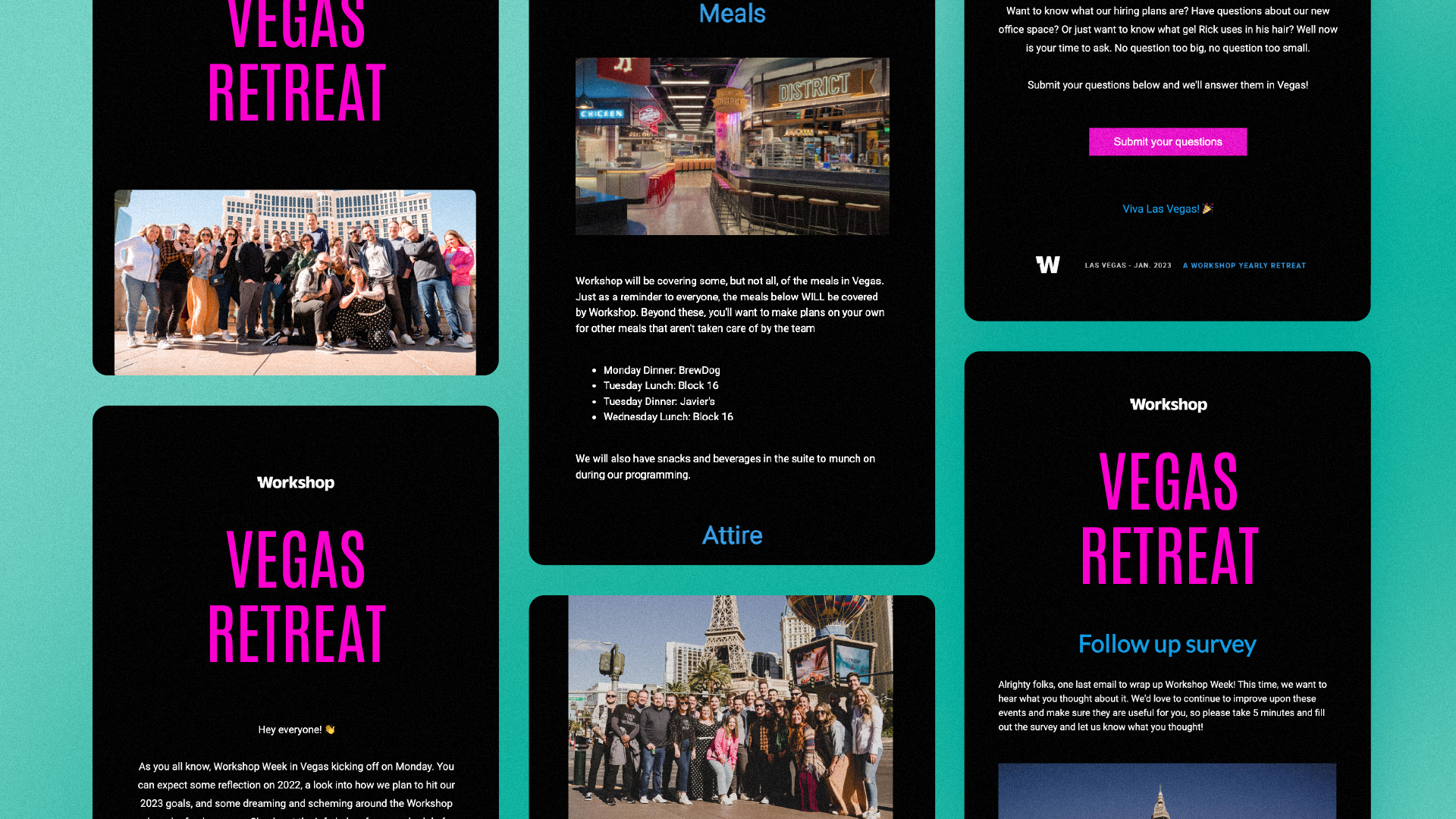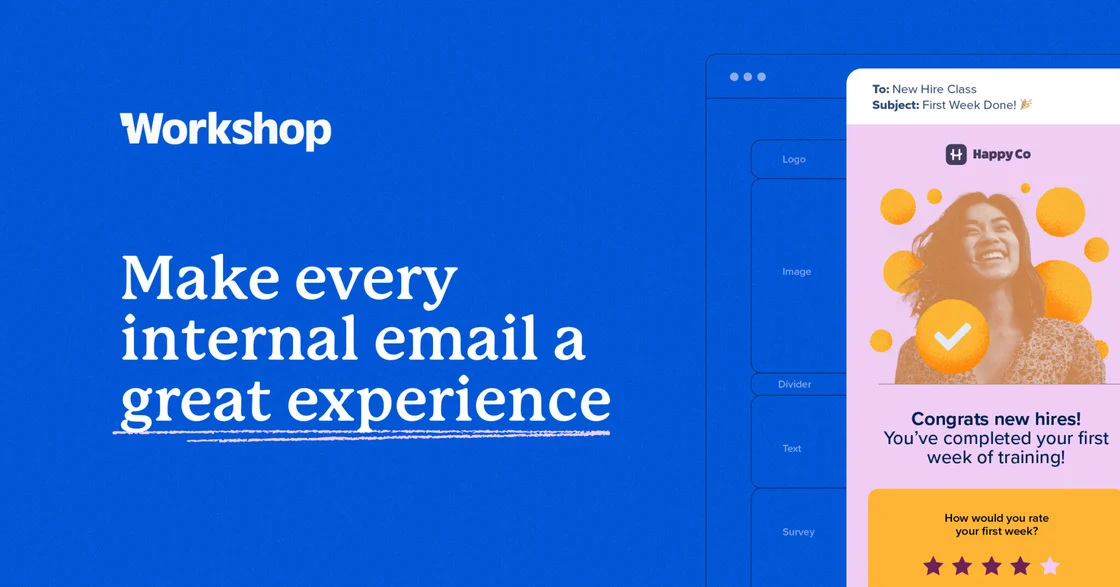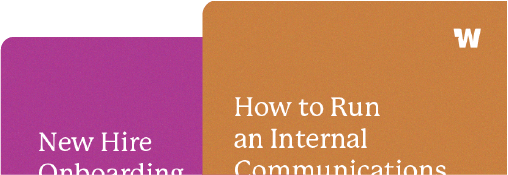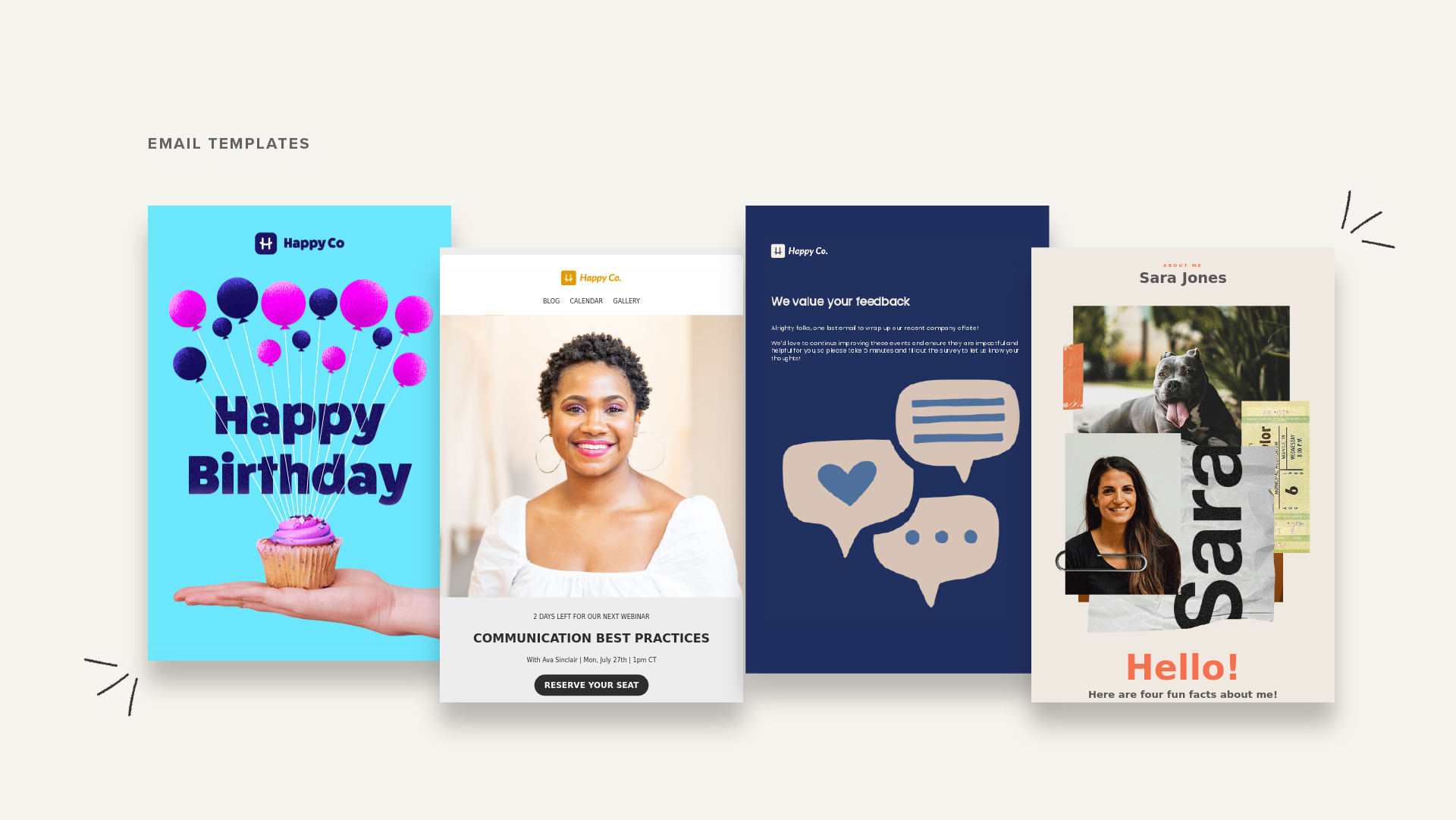How to plan internal communication campaigns (and make them great!)

Internal comms pros, your job is big. The organization is counting on you to keep a wide range of employees informed, empowered, engaged, energized, equipped… well, you know. To stay on top of employee engagement and keep the team moving forward, we love getting scrappy and incorporating strategies and tactics from other departments. Today we’re looking toward marketing; specifically the way they use internal communications campaigns.
Just like your friends in that department, you’re responsible for reaching specific audiences, communicating the right message, convincing people to take action, and reporting on your results. So shouldn’t internal comms have access to the kind of information that marketers use to organize, optimize, and analyze their work?
Um, yes! An impactful – and easy – way to do this is to start thinking of your communications in terms of campaigns. An internal communication campaign is an organized series of messages that you can look at individually, in sequence, and as a group. Campaigns bring order, efficiency, a stronger brand, incremental improvement, and the ability to prove your work’s value.
Internal comms campaigns and campaign types
A campaign is simply a series of messages that focus around a single goal. Your internal comms team is running many campaigns at a time, whether you’re thinking this way or not. Campaigns might revolve around a theme, like Weekly CEO Updates or Wellness Wednesdays, or an event, like Open Enrollment.
A campaign of emails allows you to communicate in much more mature and complex ways than one-off messages. There are four primary types of internal marketing campaigns: ongoing, event-based, triggered, and one-off.
Ongoing internal communication campaigns
Employee newsletters, employee recognition, leadership updates
- Campaigns make it easy to create branding your teams will experience with each message, increasing memorability and engagement
- Understanding your ongoing communications via a content calendar helps create a complete picture of the messages your teams are receiving
- Analyzing engagement over time helps you manage the effectiveness of your comms and make adjustments to reach more employees
Event-based internal communication campaigns
Open enrollment, charity drives, group off-sites or travel, major meetings
- Campaigns allow you to plan communication frequency and messaging changes as the date of the event approaches
- Plan messages like a marketer – first create awareness, then intent, and then trigger action
- Use campaign analytics to make sure that all of your internal audiences are receiving and engaging with the information they need for the event
Triggered internal communication campaigns
New hire communications, promotions and team changes, tech interruptions
- Campaigns let you repeat series of communications that occur regularly triggered by company or team events
- Don’t reinvent the wheel – once you create a precedent or template for these events, each can be created as a version of the previous communication
- Analytics can help you make sure that a new hire got all of their information or that everyone is aware that the VPN will be out on Thursday afternoon
One-off internal communication campaigns
Big announcements, PR-related messages
- Even if the message isn’t planned, a short campaign can help you demonstrate engagement and plan follow-up around must-hear news
- Statistics and data around these messages will give you and leader the peace-of-mind that everyone’s on the same page
How to shift to internal campaign thinking
Okay, so how do you actually shift your internal communications strategy to a campaign mindset?
- Start grouping your existing comms planning in the most logical ways that you can see. These are the campaigns you’re already running! Try and vocalize a specific goal for each campaign.
- Example campaign goals include “90% of employees read CEO newsletter, 400 sign-ups for the blood drive, or increase participation in DEI events.”
- Add campaigns at a high level to your calendaring. If you don’t have a content calendar yet, it’s time to create one! Add the start and end date of each campaign, and mark where individual messages are planned to send. The best content calendars (like Workshop’s 🙂) let you see what’s running at a campaign level first and then drill down into individual messages.
- Add campaigns to the language of your brainstorms and comms planning. When you’re thinking about your messages, ask these questions –
- What is the goal of this campaign, and how will I measure success?
- What are my audience(s)?
- What’s the expected result of this message for each audience?
- What other comms are this related to (internal or external)?
- What are the follow-ups/continuations?
- What’s the right frequency/density of sends?
- What kind of results/engagement do I expect from all the comms related to this?
- Who are the collaborators I will need to involve?
- Archive and categorize all of your campaigns for future reference and analysis
- The best internal email tools come with a campaign archive built-in so you can reference and share creative and results at any time.
- Share results with leadership and collaborative teams, at least at a campaign level
- Others in your organization will want to see the impact of internal comms… do this well enough and they’ll start coming to you!

Internal communication campaign examples and ideas
CEO newsletters
Why make this a campaign?
Your leadership is probably already sending something like this out already – and if they’re not, it’s a great idea! Regular, direct communication from key leadership connects your employees to company strategy, the news, and company updates in the most authentic way. Whether or not your leader wants to create emails entirely themselves or asks for a little ghostwriting or planning from the internal communications team, you can help facilitate sending an employee newsletter campaign that goes out regularly and engages the team.
Things to think about
- Build in a schedule and be sure to send out your CEO newsletter regularly!
- Use last week’s newsletter to make this one – templates make creation faster and much less stressful
- A dedicated email creation software can make this easy and even fun
- Don’t be afraid to include easter eggs (little hidden fun things) or create a weekly scavenger hunt to engage readers
- If your company is widely distributed, you can use campaigns and segmentation to track versions and understand who’s interacting with your sends
- Which parts of the newsletter are common through your divisions? Copy these
- Which parts need to be modified for a specific group? Segment these
- Learn if different delivery times perform better for different groups
- Sign up for our awesome Newsletter Newsletter for ideas every month
Product or project announcements
Why make this a campaign?
As an internal communicator, you’re also a uniter. Use your unique position as a cross-departmental voice to help different areas of the organization know what each other are doing. Product announcements don’t have to just be consumer-facing “products,” they can also be announcements about improvements from your tech team, or strategy updates from marketing, or something exciting from customer service. You can increase everyone’s visibility (and collaboration!).
Things to think about
- Create an internal marketing calendar for your comms team so you can track announcements and frequency
- Make it fun! These kind of announcements are a good place to share personality with memes or clever add-ins
- Source content directly from employees involved in the projects to make it more personal
Onboarding & new hire communications
Why make this a campaign?
These email series will need to be sent out from start to finish throughout the year, and continually updated for new information and accuracy. Maintaining a campaign for your team will help you keep all of the details straight, and allow you to simply update creative rather than start from scratch.
Things to think about
- You’re going to be sending out this email campaign more than once – thinking of it as one long sequence of communications will save you time and energy
- If your email tool has analytics, you can make sure that new hires have engaged with all the essential information, and send reminders as needed
- Don’t forget that important information can be fun, too – this is probably an employee’s first interaction with your brand!
- Provide access to the campaign via a campaign archive to make things easier for new hires
- Share previous campaigns (like CEO updates) with new hires so they can catch up faster

Fundraising drives or event sign-ups
Why make this a campaign?
When you have a goal to reach or a date that you’re targeting, organizing a complete internal communications campaign is the best way to plan your messages. This is where we’re saying steal from marketing. To get your audience to donate or sign up, start at the end date and work backwards to create a communication stream that drives action.
Things to think about
- Make sure all your messages include who, what, when, where, and why
- Work with your creative or marketing team to create consistent and memorable branding around your event
- The general phases of your campaign should go “awareness -> interest -> action.” You can use your editorial calendar to plan and see them in action.
- Fine-tune your campaign as you go by sending special messages (or extra messages) to people who haven’t taken action yet
- Campaigns organization and analysis will let you see who is engaging
Open enrollment & benefits information
Why make this a campaign?
It’s only once a year (thank goodness), but open enrollment campaigns are an absolute can’t-miss for your employees. And since you’re also going to onboard employees throughout the year, you can keep the entire messaging campaign up-to-date every time you send it. Campaigns also let you continually draft, edit, and save new versions of this ever-changing information.
Things to think about
- Keep your open enrollment series at hand to modify and send for new employees
- Easily see when and if new employees have engaged with required enrollment content
- Use last year’s open enrollment to create this years and don’t miss anything
DEI initiatives
Why make this a campaign?
Lack of consistency and comms around DEI (Diversity, Equity, and Inclusion) is one of the most common pitfalls. Communicating regularly about cultural initiatives is key to giving your efforts substance. Using your editorial calendar to plan and schedule messages about your cultural goals shows the level of priority and dedication you have to the cause.
Things to think about
- Include lots of real people in your messages – this topic is all about seeing each other
- Make sure that you’re communicating about your efforts and also showing and sharing community impact as often as possible
- Create an overarching and recognizable campaign theme for your initiative(s) so people look for them in their inbox
Employee recognition/kudos
Why make this a campaign?
“Have we recognized her yet?” “What did we say last time we did one of these?” Etc., etc., etc. Creating ongoing campaigns for your employee recognition emails is a simple tool that will help keep you from losing it! Sending out branded, fun, engaging recognition for team members across your organization is a great way to boost morale, strengthen relationships across department lines, and motivate employees. Thinking of these in campaigns lets you make sure that you’re (1) covering all the categories you’d like to recognize, (2) not repeating people or awards, and (3) keeping it all straight.
Things to think about
- Make it as personal or story-based as you can. Use your internal comms voice to really connect your employees better
- Keep track of how frequently you need to send out recognitions
- Create consistent “branding” so team members know what they’re looking at
- Use plenty of pictures! People want to see each other and being seen feels good.
Retreats or other group travel events
Why make this a campaign?
There’s a lot to communicate as a department – or a whole company – gets ready for a big travel event. Campaign planning lets you set up in advance to make sure everyone has schedules, events, dates, times, tickets, Uber codes, and addresses before the big day. Events are also a great use of Workshop’s campaign archives tool, which keeps every email from a campaign at a single sharable link. Employees can revisit whenever they like to check things off their personal travel list.
Things to think about
- Calendaring your travel communications well in advance helps make sure you give everyone enough time to get ready
- As you gear up for travel, keep track of everything that’s been communicated
- We love creating a fun theme for any upcoming event, it helps tie the campaign together visually
- Include a campaign archive link with each update for reference
Executing internal communication campaigns for your team
You need a calendar. There’s no better way to visual your campaigns over time and organize/prioritize how you’re going to get them out. Use an Excel or Google Doc calendar for the basics (start with our free template), or try the beautiful and simple web-based editorial calendar that comes with Workshop.
You need regular brainstorms and planning sessions. Make sure that all your ideas ladder up to company initiatives and goals, map out upcoming annual and quarterly campaigns, and be sure to set the goals for each campaign before you start putting ideas on the board.
You need to plan approvals. Make sure you know who needs to see and approve everything before it goes out. It’s a good idea to get approval of your campaign-level themes and goals first… it frequently makes approval of individual messages faster.
You need analysis. Whether or not your email tool comes with built-in analytics, you need to plan how you’ll decide if your internal comms campaigns are successful or not. Hint – it’s a lot easier with a tool 🙂. Simple statistics to keep track of are –
- Engagement over time. Measure the open rate and try adjusting subject lines and send times to improve your stats.
- Clicks or links followed. Measure whether the actions your emails request are happening.
You don’t need an email tool to start implementing campaigns into your internal communication stratey. But it sure doesn’t hurt, either! Chat with one of Workshop’s helpful, friendly representatives or book a demo today to learn more about how we can help make your messages more organized, more effective, and more fun. Get started!









